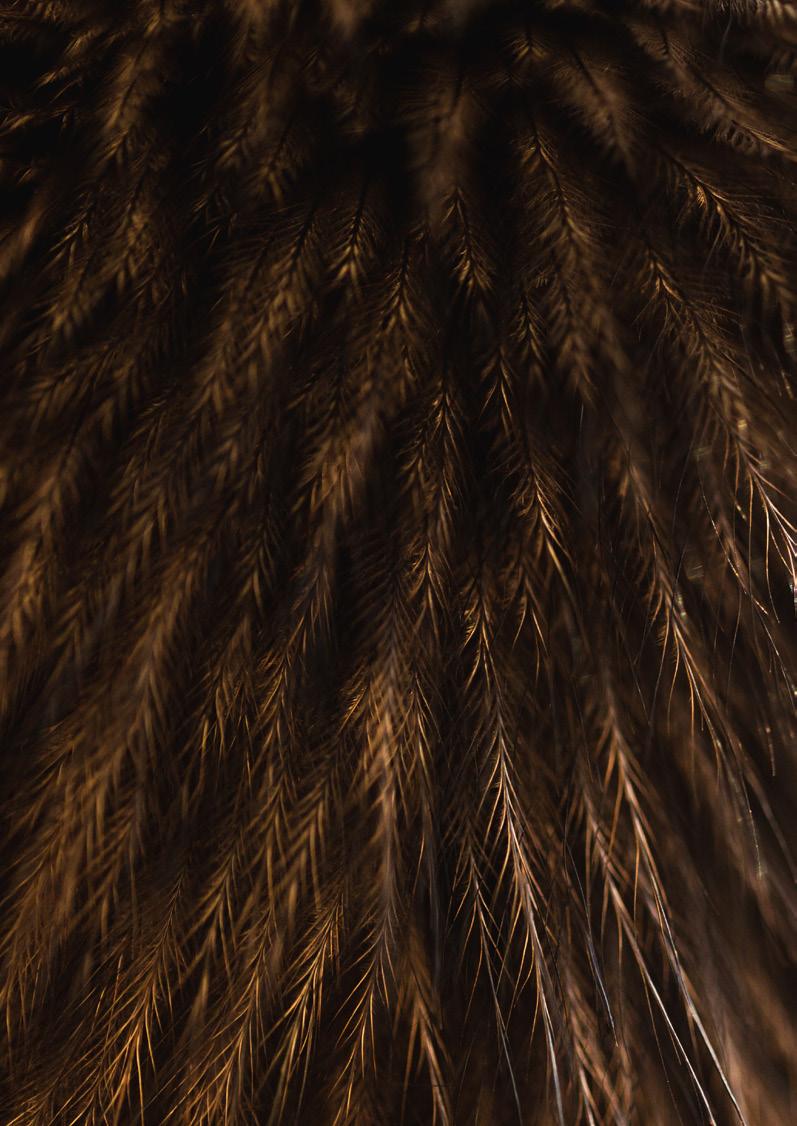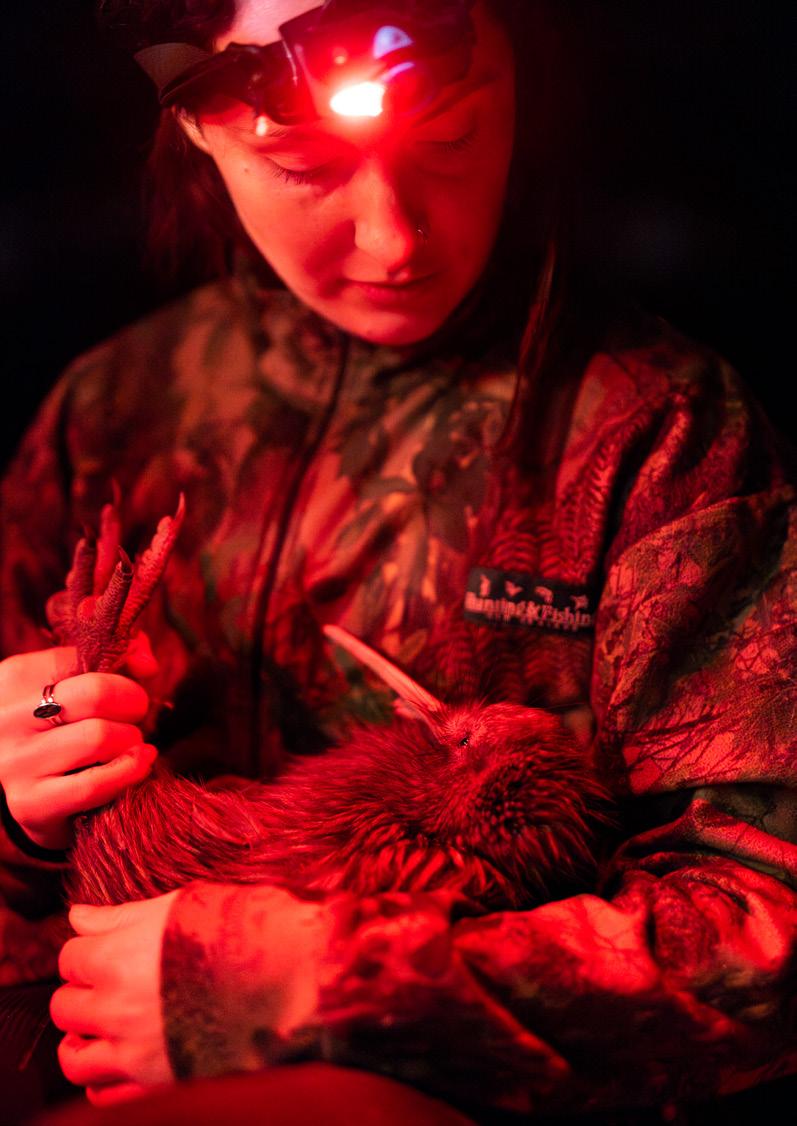
He waka eke noa.
A canoe which we are all in with no exception.

“Thanks to an estimated kiwi population of over 3,000 on the maunga, we could release 500 kiwi every year to suitable sites in the wild.”
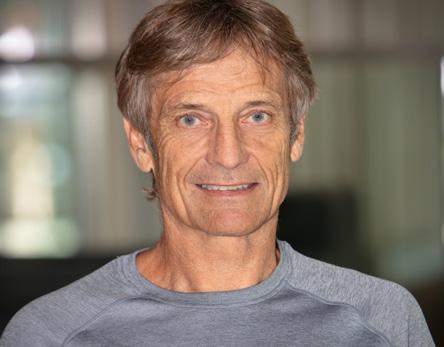


He waka eke noa.
A canoe which we are all in with no exception.

“Thanks to an estimated kiwi population of over 3,000 on the maunga, we could release 500 kiwi every year to suitable sites in the wild.”

Save the Kiwi has had another excellent year with the extensive kiwi conservation community doing great work across Aotearoa.
Our medium-term objective has been to reverse the longstanding 2% decline in kiwi numbers across all five kiwi species. We have calculated that the North Island brown kiwi is now seeing population growth of well above 2%. This is testament to the mahi being done by all the people involved in kiwi conservation in the North Island. There is still much to do – and lots of opportunity – to achieve our vision of ‘from endangered to everywhere’. We are very aware that if conservation work stopped, the reversal in population could happen very quickly.
The remaining four species are not yet at the same population level and growth rate and we acknowledge we have had less direct involvement in the South Island, where these species live. We are assessing how we can help lift the assistance we provide to kiwi-focused organisations in the South Island.
One of the reasons for the growth in the North Island brown population is the success we are seeing from the Kōhanga Kiwi kaupapa at Maungatautari in the Waikato, which Save the Kiwi leads in partnership with Ngāti Korokī Kahukura and Sanctuary Mountain Maungatautari. Thanks to an estimated kiwi population of over 3,000 on the maunga, we could release 500 kiwi every year to suitable sites in the wild.
The year to June 2025 is the last one for Jobs for Nature funding and we are very conscious of the impact this will have on the national kiwi – and overall – conservation effort. We are working with the groups we fund through the scheme to see how they can retain their conservation gains made over the last five years. We hope most gains can be maintained but accept it will be difficult for all groups to sustain their current level of activity.
Our sponsorship whānau continues to provide great support with Millennium Hotels, Petdirect, PKF New Zealand and Angel Bay joining the team this year. Gallagher Insurance continues to be a wonderful supporter and together we launched the first Kiwi Art Trail and auction in October 2023. This was a successful venture that involved a mix of well-known and up-and-coming artists who painted fibreglass kiwi sculptures which were then auctioned, with the proceeds going to Save the Kiwi. It was a great way to launch the Gallagher brand, replacing Crombie Lockwood, while raising awareness and funds for Save the Kiwi. A second Kiwi Art Trail started in October 2024, with the auction scheduled for March 2025.
Thank you to the Save the Kiwi board of directors, especially to Lady Jennie Fenwick who is doing a wonderful job gathering support and approvals for the anticipated translocation of kiwi to Auckland’s Waiheke Island, hopefully in 2025.
Save the Kiwi staff and contractors continue to do amazing work. Thank you to everyone who has contributed to another very successful year.
Looking forward, there is a large planning job ahead of the senior leadership team to ensure gains made over the over last five years thanks to Jobs for Nature funding are sustained and we can continue to make progress in growing kiwi numbers. Save the Kiwi CEO Michelle Impey will lead this work and I have every confidence she will do an excellent job, as she has done for the last 18 years.
“Over the last financial year, Save the Kiwi distributed nearly half a million dollars to support the work of others, often community-led or Māori-led projects doing predator control in their own backyards”


Michelle Impey
Conservation is an industry that is equal parts challenging and rewarding. Save the Kiwi is one of many organisations working to ensure that New Zealand remains home to its unique flora and fauna in the future. For our part in this, we have many signs of success.
Kiwi in the North Island have passed the crisis point and are now in growth mode. This is an incredible achievement for all of us, but it certainly isn’t the finish line. Many areas are still suffering local extinctions, and our aim is to grow the kiwi population to abundance across the motu. This will help build future resilience by ensuring kiwi are widespread, genetically diverse, and in large numbers.
The tentacles of this work reach far beyond bringing a threatened species back from the brink. Many people have found meaningful work, often on their own whenua. Through this work, many people are reconnecting with nature. Neighbours and communities are connecting over a common cause. Economically, we are strengthening and protecting New Zealand’s postcard to the world as a nature-loving, clean, green country.

That aside, kiwi are our core focus and we are very proud of the work we have done over the past few decades.
Over the last financial year, Save the Kiwi distributed nearly half a million dollars to support the work of others, often community-led or Māori-led projects doing predator control in their own backyards. Funding from Save the Kiwi for predator control largely focuses on key threats to kiwi: mustelids, dogs and feral cats. Many projects leverage this funding to layer in possum, deer, goat, pig and rat control with the aim of restoring a holistically healthy ecosystem. That is the magic of the ripple effect of kiwi conservation.
We are also starting to see the rewards of our Kōhanga Kiwi mahi, initiated seven years ago on the confirmation of Save our Iconic Kiwi funding from central government. SOIK is a funding package that we share with the Department of Conservation. We currently focus on North Island kiwi where community- and Māori-led projects (the lifeblood of kiwi conservation) are prevalent. Through this mahi we work with two key predator-free sites, Sanctuary Mountain Maungatautari and Motutapu Island, to build a genetically diverse source population to build wild numbers in areas where kiwi are locally extinct or need a population boost.
We are moving at a scale and pace not witnessed before in kiwi conservation. Catching and transporting hundreds of kiwi every year from one site to many others is no small feat. Our team, with the volunteers and staff at SMM, have
done a stellar job over the last two transfer seasons from Maungatautari. For the upcoming season, we are applying many learnings to explore how we build on our achievements as efficiently as possible.
This work is a reward for those who have done hard work to create a safe environment for kiwi, and now get to celebrate the return of kiwi. It motivates those who are currently restoring habitat by giving them a vision of what can happen. And it inspires those who haven’t started the journey yet but who dream of hearing the call of kiwi in their own backyards one day.
Now, our efforts turn to transitioning out of Jobs for Nature funding, both for our organisation and the projects we fund. Jobs for Nature has been an incredible boost to conservation efforts and while not all that was built will be sustained, much will. In addition to more safe habitat, we have built a skilled workforce that is employable elsewhere. We have also shown that this is an industry when resourced sufficiently (and for longer than 12 months), delivers results.
We look forward to the day when kiwi are so abundant Save the Kiwi is no longer needed. Until then, we will continue this important work. To the team at Save the Kiwi, thank you for your continued dedication to this work. To my board, our funders, our partners, and everyone on the ground doing the work whether paid or voluntary, thank you. These results couldn’t happen without you.

In February 2024, Save the Kiwi released the results of an inhouse research project that estimated the growth of the North Island brown kiwi over just four years at approximately 7000 – almost triple the increase advised by DOC needed to increase the population by 2% annually.
In the report, Save the Kiwi Operations Manager Tineke Joustra, who is also a population biologist, analysed the numbers that 25 of the projects we fund reported in 2019 and again in 2023. While this is a small percentage of projects that operate in the North Island, we are confident these results are indicative of what is happening elsewhere.
The groups included in the research were partially funded by Save the Kiwi through central government’s Save Our Iconic Kiwi (SOIK) funding package which was established in 2018 to support the population growth of each of the five species of kiwi by 2% annually. For the North Island brown kiwi to achieve this goal (measured against DOC’s base numbers dated 2018), this would require an increase of just 2,600 birds by the end of 2023.
These results are testament to the mahi Māori- and community-led kiwi conservation groups are doing all over the North Island. Where the work is being done, the tide is turning. Save the Kiwi is proud to support local conservation groups that are on the ground, working with locals, to restore the ngahere and rebuild kiwi populations, resulting in a quantifiable growth of kiwi numbers.
These results could not have been achieved without strong partnerships, collaboration, and the necessary funding. The establishment of guaranteed SOIK funding cemented the importance of the kiwi to New Zealand, not just in the public’s psyche but also with a commitment from Government that kiwi conservation is important. Save the Kiwi’s plea to Government and the Department of Conservation is to look at these results and commit to keep investing in them.

At the same time the population growth of kiwi was announced, Save the Kiwi released an independent impact report that found the change in status of the North Island brown kiwi from endangered to ‘conservation dependent’ is largely due to the efforts of Save the Kiwi and the groups and organisations we work with.
In December 2021, DOC announced that the North Island brown kiwi had been removed from their threatened list. While the species is now classified as ‘not threatened’, it comes with a ‘conservation dependent’ caveat. This means funding for intensive predator control is essential, otherwise the species will end up on the threatened list again.
In the impact report, which was commissioned by Save the Kiwi and delivered by Debbie Teale, participants said Save the Kiwi plays a valuable role in providing support and access to expertise and funding and acting as a conduit through DOC’s sometimes complex processes. Participants said Save the Kiwi has a solid management team and structure that enables them to do more than DOC can do on their own.
Participants also found that all kiwi conservation dollars invested in Save the Kiwi have a multiplier effect and impact more broadly into other conservation, biodiversity and social outcomes. Save the Kiwi is very proud of the findings of this impact report. The Māori- and community-led groups we partner with do phenomenal work. For a species of kiwi to be removed from the threatened list is an incredible achievement, and one that the entire kiwi conservation community should be very proud of. However, we all know there is still so much work to be done to keep it off that list forever.
While the North Island brown kiwi as a species is estimated to have increased in numbers, the Eastern taxa still trails its Western, Northland and Coromandel cousins. While the increase in numbers paints a good story for North Island brown kiwi overall, we need to keep building this momentum. The moment we pause is the moment numbers will very quickly go in the opposite direction.
The four other species of kiwi are also struggling. Rowi kiwi are classified as critically endangered, numbering just ~450, while the roroa/great spotted, kiwi pukupuku/little spotted, and tokoeka kiwi species are classified as nationally vulnerable.

This year, Save the Kiwi worked with our partners to ensure hundreds of kiwi made it to their new, safe homes in the wild.
In May 2024, Save the Kiwi led a team to locate and transfer kiwi from Rotoroa Island to Motutapu Island, along with spaces in the Hauraki-Coromandel region where predator control is in place. A team of specially trained kiwi dogs and their handlers located at-weight kiwi juveniles and transferred them to Motutapu Island or back to the Hauraki-Coromandel region where they originally came from.
Across the week, the teams located 26 kiwi. 16 of them were transferred by boat to Motutapu Island to join the founding population there, while seven went back to the HaurakiCoromandel region. The rest remained on Rotoroa because they hadn’t quite hit ‘stoat-proof’ weight so will be included in next year’s muster.
“To the motu and back” is part of the Save the Kiwi kōhanga kaupapa, a strategy working to accelerate the population of Coromandel brown kiwi on the mainland. Kiwi eggs lifted in the Hauraki-Coromandel region are transported to the Gallagher Kiwi Burrow in Wairakei, National Kiwi Hatchery in Rotorua, or Auckland Zoo where they are hatched and reared. Most of the resulting chicks are destined to join the founder population of kiwi on Motutapu, where they’ll live and breed the next generation of kiwi. Rotoroa Island is a midway point between the HaurakiCoromandel region and Motutapu Island. Chicks are released onto the predator-free island at around four weeks of age. Here, chicks grow without the threat of predators like stoats and ferrets ending their lives prematurely, unlike other kiwi in areas of Aotearoa where there’s no predator control.
Since the first kiwi were transferred to Motutapu in 2012, 140 have been released, with 53 of them spending time on Rotoroa first. In early-2025, it is expected that the first progeny kiwi will be transferred from Motutapu back to the Hauraki-Coromandel region.

In March 2024, 19 kiwi were transferred from Cape Sanctuary in the Hawke’s Bay to their new home deep in the heart of the Northern Ruahine Ranges, with the support of local hapū Ngāti Mihiroa, Save the Kiwi, and the Royal New Zealand Air Force.
Air Component Commander, Air Commodore Andy Scott said it was a unique privilege to relocate this taonga species to a very hard-to-get-to location in the best way they know how: flying.
“When Save the Kiwi asked the RNZAF to help transport these kiwi into the Ruahine Ranges, we jumped at the chance. The kiwi is the country’s national icon – we literally have the symbol of the kiwi on the side of our aircraft – so it was a privilege to help the repopulation of this special species.”


In March 2024, 10 kiwi were transferred from Tāwharanui to nearby Mt Tamahunga, north of Auckland, the second of three translocations in the area. Save the Kiwi supported Ngāti Manuhiri, Tamahunga Trappers and The Forest Bridge Trust in this transfer. We also assisted with training, transfers, health checks and releases.
Regular transfers also occur off Matakohe-Limestone Island in the Whangārei Harbour every year, with kiwi being released to various locations on the mainland. Save the Kiwi support Te Parawhau and Friends of MatakoheLimestone Island to carry out this work through our annual contestable funding.
In 2023, Save the Kiwi celebrated the inaugural transfers of kiwi out of Sanctuary Mountain Maungatautari, as part of Kōhanga Kiwi, a worldleading kiwi repopulation strategy driven by Save the Kiwi that is supercharging the growth of North Island brown kiwi. Last year, we transferred 111 kiwi to release sites at Tongariro and Wellington. This year, we celebrated a perfect double increase with 222 kiwi released. We also added a third release site: Taranaki Mounga.
An enormous amount of planning and work goes into carrying out a project of this magnitude. Five days a week for eight weeks, teams of kiwi dogs and their handlers searched for suitable kiwi. Each kiwi that was caught was assessed, given a full health check, and microchipped. If it was at a suitable size and weight, it was also fitted with a transmitter by a team of kiwi handlers, then re-released into a smaller part of the sanctuary until release day.
On release days, kiwi handlers used aerials and receivers to locate these kiwi via the transmitters on their legs. Kiwi received quick health once-overs, before being prepared for their final journeys to their forever homes.
This year, some kiwi got to do something they’ve never done before: fly. With the help of Wellington Aeroclub, kiwi that were destined for Mākara in the ‘wild west’ of Wellington were transported by small aircraft.
The addition of a third release site, Taranaki Mounga, was significant because most kiwi that were hatched at the Gallagher Kiwi Burrow and released onto Maungatautari originally hailed from Taranaki.
Cape Sanctuary’s conservation model, supported by Save the Kiwi and the Department of Conservation Te Papa Atawhai, proves that kiwi can thrive anywhere there’s plenty of food to eat and effective predator control. Kiwi live in the Cape’s native forest of course, but they’re also thick in the sand dunes, farmland, and pine plantations. When you take predators away and give kiwi room to grow, they’ll thrive, regardless of the landscape.

Releasing kiwi into areas where they once thrived is very important for tangata whenua and mana whenua. The kiwi is a revered taonga species and an elder of the ngahere, and working to restore kiwi populations is carried out in partnership with mana whenua.
Kiwi conservation also creates employment opportunities for people at place. As Save the Kiwi and our partners continue to boost the population of kiwi, more release sites and trained kiwi handlers will be required in the future.
During the 2024 kiwi transfer season at Sanctuary Mountain Maungatautari, a mana whenua wānanga was hosted by Ngāti Koroki Kahukura. Organised by iwi representatives from all gifting and receiving sites within this kaupapa, the wānanga created a space where all iwi involved could discuss tikanga and appropriate ways of transferring kiwi between spaces, how to work more efficiently alongside each other, and how to sustain this kaupapa long into the future.
As part of the wānanga, a team of volunteers from gifting and receiving sites were also involved in the hands-on kiwi transfer mahi. Working alongside the kiwi handling teams, these volunteers were given hands-on experience
working with kiwi, including learning how to handle a kiwi, participating in health checks, and attaching transmitters under supervision. Most of these trainees will go on to be involved in future kiwi transfers and releases, and hopefully will find employment in this area too.
Save the Kiwi led the hands-on kiwi training component of this wānanga. This was a special opportunity for our teams to sit alongside enthusiastic and engaged volunteers who were keen to learn more about this taonga species, how the kiwi ties into their own experience of te ao Māori, and what they can do to help the population continue to increase.


A kiwi transfer of this size was the first of its kind in Aotearoa, which provided an unmissable opportunity for hands-on kiwi training for kiwi handlers around the North Island. Throughout the eight weeks, many kiwi practitioners and volunteers received training and certification or renewed certification for many key kiwi handling tasks, including handling kiwi, conducting health checks, attaching transmitters, and using telemetry equipment. Some kiwi dogs in training also got the chance to improve their skillsets.
Other kiwi handlers volunteered their time simply so they could work with so many kiwi at once. One day at Maungatautari allowed some people to get up close and personal with as many kiwi they’d usually see in a whole season – and for some participants, more kiwi they’d seen in their lifetime. We could not have completed this translocation without the generous contribution of time and skills by so many of our colleagues and volunteers.
Kōhanga Kiwi is a world-leading kiwi repopulation strategy driven by Save the Kiwi that aims to supercharge the growth of North Island brown kiwi. In the first phase, kiwi eggs are lifted from the wild and incubated and hatched in captivity. Chicks are released into predator-free kōhanga sites, usually a fenced sanctuary or island, when they are about four weeks old, where they’ll live the rest of their days finding a mate and breeding, without fear of predators. In the second phase, when these kōhanga sites reach an estimated half-capacity, the offspring of the original founder population will be either returned to the regions where their ancestors came from or used to bolster existing populations or create new ones.
In partnership with iwi and other organisations, Save the Kiwi operates Kōhanga Kiwi at Sanctuary Mountain Maungatautari in south Waikato (for Western brown kiwi) and Motutapu Island in Auckland’s Hauraki Gulf (for Coromandel brown kiwi). We have completed phase one at both sites and are onto phase two which is to return kiwi to safe places in the wild.
Before the transfer season started, Ngāti Koroki Kahukura and Save the Kiwi invited Pukeatua School, which sits at the base of Maungatautari, to be involved in this year’s kiwi transfer. The small, country school jumped at the chance to not only share this unique opportunity with its students but also to donate some space within the school grounds to the operations of the kaupapa.
Pukeatua School allowed our team to use an unused classroom which we transformed into our kiwi processing HQ. All kiwi located by dog teams on the maunga were brought here, where they underwent health checks and were microchipped. This site also became everyone’s ‘home away from home’, where meetings were held, planning was carried out, and visitors were shown around.
Primary school students and staff were invited to participate in this kaupapa including watching health checks and re-releasing kiwi back into the sanctuary.
Dene Franklin, principal of Pukeatua School, said it was an incredible experience for him, his staff and his students to be so actively involved in.
“It was so special having kiwi come off Maungatautari and having the kids being able to see something that hundreds and thousands of New Zealanders have not seen so close before. To know that Pukeatua School and our wider community have been involved in helping kiwi spread across the country and knowing the kiwi population is going to boom because of the support we’ve been able to provide Save the Kiwi and Sanctuary Mountain Maungatautari is just incredible.”
Franklin said there were other benefits of his students being so close to kiwi too.
“We had some of our reluctant junior writers writing whole pages and filling up their whole planning sheets with the information and knowledge of kiwi learnt from the experiences Save the Kiwi provided. Even the conversations at lunchtime with kids and in the carpark with parents have shown how special this has been to Pukeatua School and the wider community.”
When Kōhanga Kiwi was first conceived, many people didn’t think it would work. To have now transferred 333 kiwi from Maungatautari to safe places in the wild is an incredible achievement for Save the Kiwi and our partners.
This is only the beginning. Numbering at an estimated 2,500, the kiwi population at Sanctuary Mountain Maungatautari is now large enough to sustain itself. This means that every year hundreds of kiwi can be transferred to other safe places in the Western region.
We are actively assessing where future release sites could be. We know we have the kiwi, and we know there are many suitable places where kiwi could go.
‘Saving kiwi’ doesn’t just mean moving birds from one place to another. A huge amount of the work that Save the Kiwi does influences system change and supports kiwi conservation efforts all over the country.
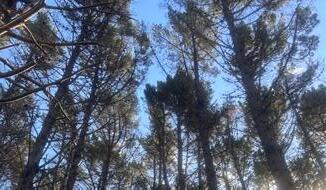
Pine a promising solution to the decline
Many people assume that kiwi only live in native forest. In fact, kiwi can live – and thrive – just about anywhere if there is enough food, water, shelter and protection from predators. That includes pine forest.
Over the last two decades, interest and knowledge about kiwi in plantation forests have increased, along with a feeling of responsibility and a desire to protect kiwi that already live there. This interest stems in part from a growing commitment to the natural environment, needing to comply with resource consent conditions imposed by regional councils, district councils and other territorial authorities, and in part to meet sustainable forestry certification standards.
Plantation forests have been proven as good habitat for kiwi. The soil is usually damp enough for kiwi to probe into, and the pine needle cover makes it easy to find food. In some areas, kiwi have naturally migrated from native forest into pine, and some plantation forests are now home to thriving populations of kiwi.
All over New Zealand, collaborative efforts are in place to ensure kiwi can thrive in all habitats, including exotic plantation forests. There are approximately 1.7 million ha of plantation forests in New Zealand. This number offers a significant opportunity for kiwi conservationists to expand their work beyond the boundaries of native forests.
To learn more about how kiwi and commercial plantation forests can co-exist, Save the Kiwi is starting an extensive research project in early-2025 into the effects of modern forest harvesting techniques on resident kiwi populations. This research project will track the movements of resident kiwi over five different harvest sites over the next five years, to understand more about how kiwi react to their pine plantation habitat being harvested.
Over the last financial year, Save the Kiwi has invested a significant amount of energy into managing and improving the Kiwi Avoidance Training programme. Jointly established in 1996 by Save the Kiwi and the Department of Conservation, kiwi avoidance training is one method that can help keep kiwi safe from “dogs with jobs” like hunting dogs and farming dogs that work in areas where kiwi live.
Since appointing Emma Craig as our inhouse dog specialist in 2023, the kiwi avoidance training programme has seen a massive uptake. In the last financial year, 3,307 dogs went through kiwi avoidance training with an endorsed trainer. Six trainees and four trainers joined the team, taking the number who work from the Far North to Rakiura Steward Island to 42.
The ongoing development of the Kiwi Avoidance Training app is making it easier to manage dogs and certification too.
There is a huge amount of demand for kiwi avoidance training all over the country which is very encouraging to those who work in kiwi conservation. While getting a dog kiwi avoidance trained isn’t a silver bullet, it’s one way to help make kiwi safer.
In the coming year we are looking for funding to expand the programme and make it more accessible to more communities.

In August 2023, six kiwi were killed by dogs in Ōpua Forest, in the Bay of Islands. All were discovered within a 500-metre radius and had injuries consistent with being gripped in a dog’s jaws.
Also in August, and also in Northland, a man was convicted for the death of a kiwi chick and fined $1,500 while his border collie was put down.
In response to these and other kiwi deaths by dogs around the country, Save the Kiwi, supported by DOC, launched a campaign called “Where’s your dog at?” to encourage dog owners to prevent their dog from roaming. The campaign aimed to raise awareness about the risks roaming dogs pose to themselves, other dogs, people, and wildlife including kiwi.
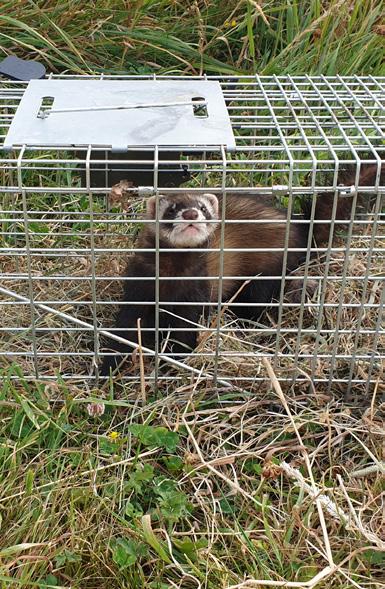
While stoats are the biggest threat to kiwi chicks, ferrets are one of the most significant threats to adults. Unfortunately, in recent years ferrets are being reported (and thankfully caught) more often, and are increasingly being reported in areas they haven’t been seen in before.
In response to the rising threat of ferrets and relative lack of information about how to combat them, Save the Kiwi’s National Predator Control Advisor John Bissell has been developing a range of ferret-related tools and guidelines. These are designed to upskill kiwi projects with the necessary skills to improve trapping regimes so they’re more likely to successfully trap ferrets and eliminate them from their projects.
The number of predation events is increasing all over the country and the need to have proven and trained predator hunters available as ‘first responders’ is becoming increasingly important.
Save the Kiwi assembled a small group of trusted predator hunters, led by National Predator Control Advisor John Bissell, who are local experts at dealing with predation events. The members of the Predator Response Team have been handpicked from around the North Island and chosen for their results in the field and ability to connect with people on the ground.
When projects inevitably experience a predation event, they now have access to local, on-the-ground predator hunters who have been trained to respond effectively.

In January, Save the Kiwi undertook a ‘research reconnaissance’ on Auckland’s Rangitoto Island to learn more about the suitability of the island for kiwi.
Neighbouring Motutapu Island is home to a thriving population of kiwi that hail from Hauraki-Coromandel. The islands are connected by a large intertidal area and causeway bridge and over the years some kiwi have caught the travel bug and have wandered from Motutapu to Rangitoto.
Not enough is known about the year-round suitability of Rangitoto for kiwi in terms of habitat and water supply. Because the temperatures on volcanic rock can reach up to 70 degrees Celsius, Save the Kiwi wants to gain greater insight into the state of the health of any kiwi that live on Rangitoto and move them somewhere we know they’ll thrive.
Save the Kiwi’s Will Kahu, Al Grant and James McLaughlin spent a few days on Rangitoto using kiwi dog Charlie and a range of other tools to locate kiwi and relocate them to Rotoroa Island (with support from Heletranz Helicopters when ferry and water taxi availability didn’t work).
During their time on the motu, the team relocated four kiwi that are founders of Motutapu’s breeding population. In due course they’ll be returned to Motutapu in the hopes they will resettle in a better location on the island and continue breeding the next generation of kiwi on the motu.
We are working with DOC and Ngāi tai ki Tāmaki to reduce the number of kiwi that can make their way onto Rangitoto in the future.

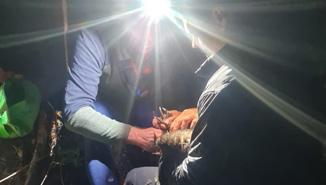

Save the Kiwi’s work revolves around, well, saving the kiwi. It’s in the name, after all. However, the work to protect kiwi and make habitat safer goes far beyond this taonga species.
Trapping to protect kiwi focuses on mustelid control: removing stoats, ferrets and weasels from the landscape. This trapping works to protect other native ground-dwellers too, like penguins, geckos, skinks, wētā and critically endangered species like the Archey’s and Hochstetter’s frogs. Many projects that start with mustelid control expand their trapping regimes to include rats and possums. Combined, these trapping measures remove more pests and predators from the ngahere, which is an excellent thing for both flora and fauna.
Some areas where kiwi conservation work does or could happen are geographically isolated, and there aren’t many employment opportunities. To monitor kiwi and create safe spaces for the return of this taonga species, we need people on the ground to do the mahi. Training willing and able people to carry out this work gives them a selection of skills to become a confident, well-rounded conservation worker which, combined with other skills, strengthens their future employment opportunities.
Working on a common goal like returning kiwi to a community has the unique ability to bring people together. It’s a big dream that people wholeheartedly believe in, but which can only be achieved if the whole community gets onboard.
Many visitors to Aotearoa dream of seeing a kiwi in the wild and will build their itineraries around this. Therefore, the work to protect kiwi has a direct economic benefit on local communities too.
Organisations that are involved in kiwi conservation and other environmental initiatives help to instil a sense of pride among their employees and reinforce positive values and may help with attracting or retaining staff.





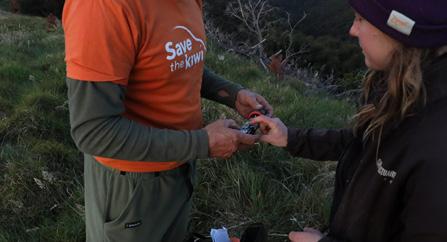
Over the last financial year, Save the Kiwi continued to see significant momentum in our whānau of projects funded by Jobs for Nature. Since mid-2020, the Department of Conservation has been responsible for allocating $488 million to partners and projects to create nature-based job opportunities for approximately 4,800 people. Save the Kiwi has been responsible for distributing $19.7 million of that funding.
Over the last financial year, we have continued to prove the value of the ‘fund one, distribute to many’ model. We fund 11 independent projects through Jobs for Nature from the Bay of Islands in Northland to the West Coast of the South Island. Jobs for Nature also funds several inhouse Save the Kiwi functions, including Māori engagement, comms and marketing, and forestry and dog specialists.
We can proudly say that every one of our groups are powerhouses that have smashed their targets and seen incredible results, not just for kiwi but also for greater biodiversity. In the 2023/24 financial year, our projects created a combined 56 fulltime equivalents (FTEs), bringing the lifetime total to 178 FTEs, smashing our combined lifetime goal of 100 FTEs quite comfortably. Combined, an additional 29,500 hectares were put under predator control, adding up to a total of 149,600 hectares across the funding period, again smashing the target of 104,000ha.
Jobs for Nature has been a godsend for many projects right across the country. After struggling for decades, many groups are celebrating that their work has been validated with this funding injection. It has enabled them to provide stable employment for people at place (and in some cases, created jobs that people had left the area could come back to take up). It has validated environment-related tasks as important and necessary work. It has reconnected many people with their communities and the wildlife that lives within them. Of course, it has resulted in significant biodiversity gains across the entire environmental ecosystem including weed and pest management and freshwater and planting projects.
However, with Jobs for Nature set to finish in the middle of 2025, there is now a very real fear that the biodiversity gains made since the scheme launched in 2020 will fall off a cliff. We hope this and future governments will prioritise the environment by investing in biodiversity and ensuring the future of conservation projects across Aotearoa.

As Jobs for Nature wraps up and budgets get tighter, what does the future of conservation funding look like?
Conservation is a key part of New Zealand’s tourism sector. Many international visitors come to our corner of the globe to see clean, green spaces teeming with unique wildlife and birdsong – and maybe see a kiwi while they’re here.
Unfortunately, conservation and overall biodiversity gains have run on the smell of an oily rag for a very long time. Funding is always scarce regardless of species, and volunteers have been relied upon to carry out essential and often highly skilled work. Now, with the end of Jobs for Nature, the future of conservation is looking even harder.
Current funding sources
Save the Kiwi and the Department of Conservation are the recipients of central government’s Save Our Iconic Kiwi (SOIK) funding which was established in 2018 to support the population growth of each of the five species of kiwi by 2% annually. We use our portion of this funding to fund local
kiwi conservation groups who are doing the hard mahi on the ground to rebuild kiwi populations. During the 2023/24 financial year, we funded 33 projects a total of $446,500.
Over the last four years, Jobs for Nature has been our most significant source of funding. With that scheme finishing in mid-2025, the projects we fund are now working on securing other funding sources.
To fund the rest of our work, Save the Kiwi has a wonderful family of sponsors and donors. We are always grateful for support, but especially so in a tough economic climate.
The role of volunteers
Conservation work relies heavily on volunteers, and this work couldn’t happen without them. At the same time, not everyone has the luxury of being able to donate their time.
The conservation sector needs people who have skills to do this mahi, and they need to be paid a fair wage. Too often we expect people who do things ‘for the greater good’ to do them for free or less than fair pay, which just isn’t sustainable – for them or for conservation efforts. Volunteers will always be essential, but for some roles, in order to attract and retain skilled people we need to be able to pay them.


Raukūmara Pae Maunga is on a mission to return taonga species to the Raukūmara with the support of Save the Kiwi.

The Raukūmara Range is part of the largest contiguous native forest left in the North Island. Two iwi, Te Whānau-a-Apanui and Ngāti Porou, have shared love, life, warfare, raids and peaceful times. What also joins them is their whakapapa to this ancient landscape, the Raukūmara forest.
Saving the Raukūmara is the ambition of these two iwi, and their hard work has culminated into Raukūmara Pae Maunga, an iwi-led restoration project looking to bring back taonga species such as kiwi to the Raukūmara.
Introduced deer and possums that had arrived by the 1960s have eaten their way through this forest, seriously reducing the canopy and understory. In many areas, forest floor leaf litter has been eaten and the ground has been compacted by hard hooves. When the rain falls now, it comes pouring through the reduced canopy and understory, pushing the forest floor down into the rivers and out to sea. The East Cape has one of the largest sediment yields in the country.
For many years, Save the Kiwi has been working with iwi to support their aspirations. Morgan Cox, Ora Barlow and Wongi Wharepapa are part of the Save the Kiwi team that works in this complex space. Since 2022, Wongi, who works fulltime for Save the Kiwi, has been instrumental in engaging with his iwi in the Raukūmara Pae Maunga roll-out of their extensive aerial 1080 operation.
“One of the biggest reasons I came home was to work for my whenua and our people,” says Wongi. “Save the Kiwi really backed me to come home and do this work. Now I engage with our rangatahi (young people), hapū, kura (schools), land blocks, hunters and pakeke (adults) – all our people, really – as well as folks outside of our iwi.
“My role is to work with everyone, so we can all come together to work on a common goal which is to breathe new life into the Raukūmara.”
Wongi’s long-term goal is to create a healthy, flourishing habitat so native birds, including kiwi, can one day return to the area. He is philosophical about his work though.
“I know people say that we are doing this work for our mokopuna (grandchildren), but I want to say that we are doing this work for our pakeke because I want them to see kiwi return to Raukumara in their lifetime,” he says. “It’s going to take a lot of work, a lot of time, and a lot of collaboration between a lot of people to make this a reality.
“But I hope that the work that I’m doing now will leave a legacy of kiwi roaming freely throughout the Raukūmara.”



In April, Save the Kiwi and Rotoroa Island Trust had the privilege of hosting the New Zealand and Australian Governors-General, The Right Honourable Dame Cindy Kiro and The Honourable David Hurley, on an intimate kiwi release on Rotoroa Island.
This was the first state visit by the Australian GovernorGeneral to New Zealand in five years, so it was an honour to play a part in this important occasion.
The visit began with a pōwhiri onto the island hosted by Ngāi Tai ki Tāmaki and Ngāti Pāoa. Our esteemed guests then learned about the work that Save the Kiwi and Rotoroa Island Trust does to guarantee the future of the Coromandel brown kiwi population. They then got up close and personal with a chick known as “Cove” before releasing it onto the predator-proof island.

Save the Kiwi CEO Michelle Impey was a semi-finalist for the Ministry for the Environment | Manatū mō te Taiao Te Toa Taiao o te Tau New Zealand Environmental Hero (now Sustainability Leader) of the Year, as part of the Kiwibank New Zealander of the Year Awards 2024.
“I’m honoured to work in an industry that’s so deeply passionate about something so tangible and lifeaffirming as conservation. Over the last 18 years that I’ve been a part of Save the Kiwi, I have seen incredible growth and progress in kiwi conservation.
“Much of these gains come down to the army of hapū-, iwi- and community-led conservation groups that span much of Aotearoa and are wholeheartedly committed to a vision of kiwi returning to their corner of the country.
“This nomination might have my name on it, but it’s for everyone who works to restore kiwi populations. Save the Kiwi used to produce a t-shirt that says, “We won’t rest until they’re a pest!” on the front. What a privilege it is to work alongside people with the same vision.”
Congratulations to Nicola MacDonald who took out the award.
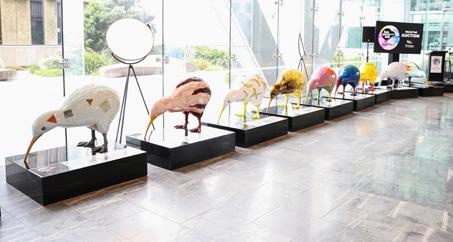


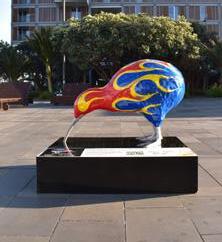


In October 2023, 20 kiwi sculptures appeared on the streets of Downtown Auckland as part of the inaugural Kiwi Art Trail.
Presented by Save the Kiwi and principal sponsor Gallagher Insurance, the Kiwi Art Trail combined art with the mission to save the kiwi. The Kiwi Art Trail featured 20 kiwi sculptures designed by a range of talented New Zealand artists, including Otis Frizzell, Mike Weston, FLOX, SWEATS, Amanda Billing, Byron Romer, Sarah Oostendorp, and Kat Quin.
At the end of the trail, the sculptures were auctioned, selling for $70,000. Proceeds were donated to kiwi conservation.
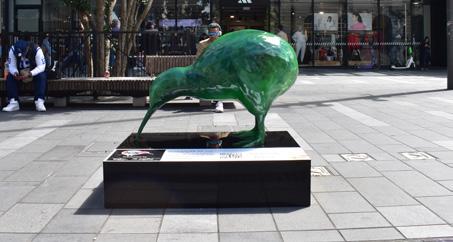



Artists Otis Frizzell and Mike Weston designed a kiwi sculpture each, plus the pair worked on a collaboration as part of their joint artistic brand, Weston Frizzell. Frizzell’s kiwi was designed to look like a solid piece of pounamu (greenstone), while Weston’s “Kiwi Battler” blended his love of military aircraft with the urgency of the kiwi population’s restoration. Weston Frizzell’s “Kiwi Knievel” was a fun take on Evil Knievel’s helmet, referencing the pair’s iconic artistic style.
Contributing artist Sarah Oostendorp took inspiration for
her “Tāmaki Makaurau’s Tokoeka” sculpture from her South Island upbringing.
“I encountered wild kiwi once when I was little, on Stewart Island,” she says. “I saw their footprints in the sand and could hear them at night. Being a Southland girl living in Tāmaki Makaurau, I wanted the name of this kiwi to have a reference to my home. It feels like I’m bringing a piece of my home to the streets of Auckland where kiwi could have once lived.”
Save the Kiwi, along with the community, hāpu and iwi conservation projects that we support, could not do what we do without the support of our committed whānau of sponsors and supporters. We are proud to partner with some of Aotearoa’s most iconic brands who not only do good things for the people of New Zealand but also want to do good things for kiwi conservation.

















In July 2023, Millennium Hotels and Resorts New Zealand started sponsoring Save the Kiwi. In addition to their sponsorship, all guests to any Millennium, Grand Millennium, Copthorne, Kingsgate or M Social hotels in New Zealand can choose to opt out of daily room servicing. The cost that servicing would have incurred is donated to Save the Kiwi and earmarked to help run the Napier kiwi creche.

We also welcomed accountancy network PKF New Zealand to the team this financial year. During the 2024 kiwi transfers, PKF Hamilton visited Sanctuary Mountain Maungatautari and participated in a kiwi release.

In March 2024, we welcomed Kiwi-grown pet company Petdirect to the sponsorship team. Plus, when cat and dog owners shop at Petdirect, they can now choose to add a donation to Save the Kiwi at checkout.

Just in time for the 2024 Olympics, Angel Bay and Save the Kiwi ambassador Dame Lisa Carrington teamed up to create a limited-edition burger patty: the Smokey Barbeque beef burger. They’re still available at all good supermarkets in the frozen section, plus $1 from every pack sold will be donated to Save the Kiwi.

In October, Save the Kiwi sponsor Crombie Lockwood rebranded to Gallagher Insurance. At the same time, the Crombie Lockwood Kiwi Burrow became the Gallagher Kiwi Burrow. Different name, same important mahi! Gallagher Insurance is also the principal sponsor of the Kiwi Art Trail.
The 2024/25 financial year is already looking busy!
First progeny kiwi to be transferred off Motutapu Island (permit-dependent)
A fourth release site from Sanctuary Mountain Maungatautari
Increased work in the South Island
Developing a kiwi transfer plan for Northland’s Matakohe Island
Kiwi to be released onto Waiheke Island (permit-dependent)
Development of another kōhanga site in the Eastern region
Kiwi Art Trail 2024/25 in Tauranga, Napier, Whangārei and Auckland
Little spotted kiwi to be transferred from Kapiti Island to Brook Waimārama Sanctuary


Michelle Impey
Manahautū
Executive Director

Paul O’Shea
Pou Tahua
Whakarite Kaupapa
Incubation Team Leader & Account Manager
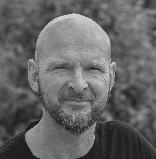
Ross Halpin
Pou Matua Rapu Pūtea
Marketing & Sponsorship General Manager

Morgan Cox
Pou Uruao a Motu
Māori Engagement
National Coordinator

Tineke Joustra
Pou Matarau
Operations Manager

Ora Barlow
Pou Uruao a Motu
Māori Engagement
National Coordinator







Save the Kiwi shares a goal with the Department of Conservation, its long-time partner in the national kiwi recovery programme, to increase each species of kiwi by 2% per annum. Save the Kiwi is responsible for distributing funds to the community from the successful “Save our Iconic Kiwi” bid to Treasury by Kiwis for kiwi and DOC together in 2015. For this year, the fund for community was just under $500,000.
STATEMENT OF FINANCIAL POSITION FOR THE YEAR ENDED 30 JUNE 2024
BALANCE SHEET AS AT 30TH JUNE 2024
The Department of Conservation’s Save Our Iconic Kiwi funding allows us to support community and Māori-led kiwi conservation groups via our annual contestable funding grants.
Controlling predators in kiwi habitat is the prime focus of the hundreds of community-led kiwi conservation groups around the country. The work done also provides a haven for other native birds, reptiles, and insects. Save Our Iconic Kiwi funding helps these projects set up and maintain hundreds of trap lines that form a protective shield against invasive pests and predators like stoats, ferrets, and rats. This safe habitat will be home to the increased numbers of kiwi that we will breed in years to come.
Rearing chicks in secure facilities gives them the best chance of surviving until they reach around 1kg in weight, at which point they are much less vulnerable to predation. Operation Nest Egg (ONE) is a highly effective way of increasing the survival rates of kiwi chicks so they have more chance of reaching breeding age and contributing to increasing kiwi populations.
To coordinate projects that rely heavily on volunteers and run 365 days a year often requires full-time staff support. We recognise the necessity of these roles and provide administration and project support funding. We also support advocacy work and kiwi avoidance training for dogs.
Predator control: 66%
Operation Nest Egg: 14%
Monitoring & translocations: 8%
Project support: 8%
Research: 4%
In order to know when we can lift eggs, keep an eye on the overall health and genetic diversity of kiwi populations, and understand what’s going on in the wild, we need to monitor kiwi. Translocations are used to manage genetic diversity, move kiwi into underpopulated, but protected, areas, and support ONE.
